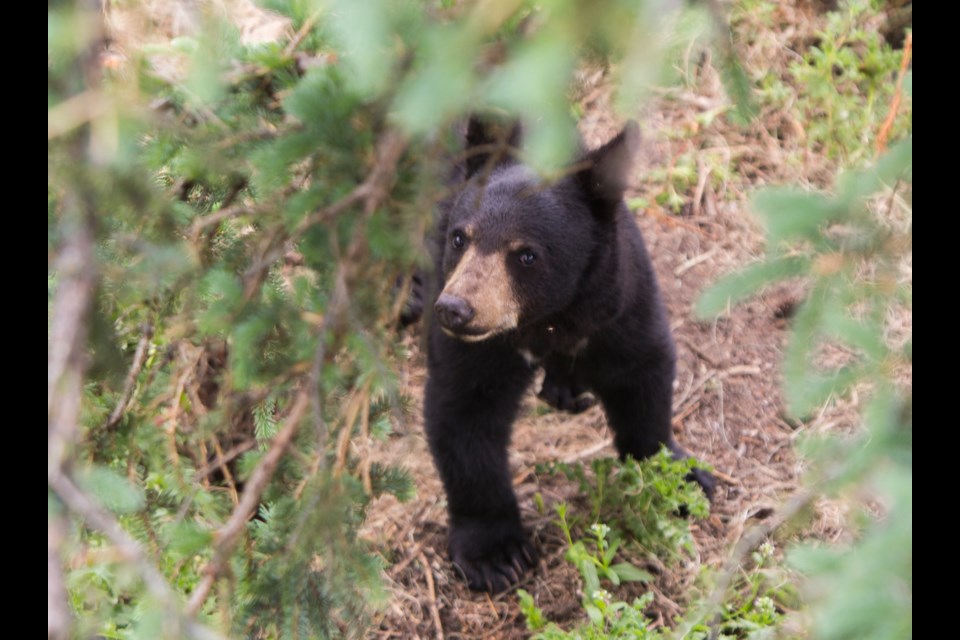After nursing an orphaned black bear since the spring, a local wildlife rehab centre is frustrated with Alberta Environment and Parks' (AEP) decisions regarding the release of the cub into the wild.
Cochrane Ecological Institute (CEI) president Clio Smeeton said it has been frustrating working with Alberta Parks to find a safe place to release orphan bear cub Siksi’namm into the wild. CEI cared for the cub since it was abandoned in a box in the charity’s parking lot in the spring.
The provincial government took the bear Oct. 20, Smeeton said, and she is concerned about where the bear cub has been released. She added the government refused to disclose where the bear was relocated.
When a wild animal is released, the goal is for it to stay are put because they are in an optimum habitat with minimal human disturbance, Smeeton said, and she is concerned one of the proposed new homes for Siksi’namm may be in the Ghost Public Land Zone, which does not meet those criteria.
“The proposed release site is not ‘remote,’ it is not ‘good habitat,’” Smeeton said. “If you’re looking for maximum disturbance that is the optimum place.”
Smeeton said there have been concerns the bear could be released into the Ghost Lake area, which has multiple land uses including logging, hunting, camping and recreational vehicle access.
On Oct. 3, The Cochrane Eagle reported concerns about random camping, human waste, target shooting and illegal campfires in Alberta’s foothills, including in the Ghost wilderness area, which covers about 947 square kilometres of land.
“That’s not good for bears," Smeeton said. "That’s just going to bring them down to where humans are. It’s the wrong place; let’s find the right place.”
In a statement, John Muir, director of Communications with AEP said Alberta’s black bear rehabilitation protocol recommends bears be released into the same area where they were found.
"Since we do not know where this bear came from, the department had to assess other locations that will meet the needs of the bear," he said. "For bear releases, our top priority is always the well-being of the animal. We look for areas with good habitat and remote settings away from people."
According to Muir, the Ghost Recreation Land Zone was initially chosen because it met those requirements.
"We heard Albertans’ concerns about the Ghost Recreation Land Zone and found an alternate release site that will also be suitable for the bear," he said. "We want to assure Albertans that the bear will be in a remote setting as far away from people as possible. Bear release sites are not made publicly available in order to give the bear the best possible chance of survival and prevent potential contact with humans. The bear will be collared so that the department can keep track of how it's doing in the wild."
Smeeton added CEI is willing to work with the government to research the best locations for release to ensure Siksi’namm will have the greatest possible opportunity to thrive.
“They download the responsibility on to us, they download the costs on to us so why don’t they say to us, ‘Do what you’ve always done up until 2018, find the release sites then come to us,’” Smeeton said, adding more collaboration is needed when finding a release site for orphaned bears.
Together they can create a “win-win” situation, Smeeton said, where bears find a safe place to live and the government shows they care about the success of wildlife in the province.
CEI has been working with orphaned bears since 1985.
“If you think about if you let cubs go in a hibernating box, which was what we were using from 1993 on, the cubs would go into the box in the middle of November," Smeeton said. "Then the box with the hibernating bear in it could be moved to the previously researched release site anytime from late December to mid-March."
By then, hunting season has passed and older, predatory bears that would eat an eight-month-old cub are hibernating, she said. Bears can wake up in a new world but stay where they are put because they were released in a familiar “cave."
In the past, CEI worked with Fish and Wildlife when releasing bears to ensure the animal was moved somewhere it would be safe from hunters or predatory encounters. This is now difficult because animal populations are not being monitored prior to the release of a bear.
One of the most important aspects of releasing young animals into the wild is ensuring it is done at the time they would normally separate from the parental group, Smeeton added. A black bear will separate around the age of two or three years old, depending on its sex and availability of food.
“You want the animals you release to stay there and not get into trouble with humans again. It is possible to find places like that," Smeeton said. “We really need to think about these possibilities because we want the best for the animals."



